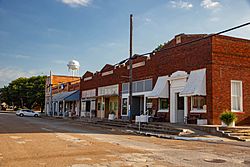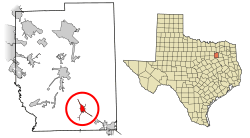Kemp, Texas facts for kids
Quick facts for kids
Kemp, Texas
|
|
|---|---|

Downtown Kemp, Texas
|
|
| Motto(s):
Easy Livin'
|
|

Location of Kemp in Kaufman County, Texas
|
|
| Country | United States |
| State | Texas |
| County | Kaufman |
| Incorporated | May 18, 1922 |
| Government | |
| • Type | Type A General Law Municipality |
| Area | |
| • Total | 2.20 sq mi (5.69 km2) |
| • Land | 2.13 sq mi (5.52 km2) |
| • Water | 0.06 sq mi (0.17 km2) |
| Elevation | 381 ft (116 m) |
| Population
(2020)
|
|
| • Total | 1,129 |
| • Density | 513.2/sq mi (198.42/km2) |
| Time zone | UTC-6 (Central (CST)) |
| • Summer (DST) | UTC-5 (CDT) |
| ZIP code |
75143
|
| Area code(s) | 430, 903 |
| FIPS code | 48-38788 |
| GNIS feature ID | 2412823 |
Kemp is a small city in Kaufman County, Texas, United States. In 2020, about 1,129 people lived there. It's known for its friendly, "Easy Livin'" motto.
Contents
History of Kemp
Early Days and Naming
The community of Kemp was named after Sara Kemp, who was the mother of Levi Noble. Levi Noble became the first postmaster (the person in charge of the post office) in the area. The town officially started when its post office opened in 1851.
At first, Kemp grew slowly. A church for Presbyterians was started in 1854. Later, in 1867, a school called the Kemp Academy of Learning began. After the American Civil War, more and more people moved to the community.
The Railroad Arrives
In 1870, a doctor named A. J. Still bought land north of the original town. He hoped a railroad would come through the area. He divided his land into lots and offered some to the Southern Pacific Railroad company. Another early settler, Sam Parmalee, also gave land for the railroad tracks.
By the mid-1880s, the railroad line was finished. A train station was built, and Kemp became an important stop on the line. This brought many new settlers to the town.
Growth and Changes
Kemp became a busy trading center for the southern part of Kaufman County. It was important for nearby cattle ranches and cotton farms. By the early 1900s, about 513 people lived in Kemp. Methodist and Baptist churches were built. The town even had its own newspaper, the Kemp News.
In 1926, Kemp had grown to about 1,200 people. There were sixty businesses and two banks. However, the population and businesses slowly decreased after World War II.
A big change happened in 1965 when the Cedar Creek Reservoir was finished just south of Kemp. This large lake helped the area. By 1990, Kemp had 1,184 people and 75 businesses. Many people living in Kemp also traveled to jobs in the larger Dallas area.
In 2011, Kemp got national attention because of its old water system. This problem became more noticeable during a very dry period in Texas.
Geography
Kemp is located in the southeastern part of Kaufman County. U.S. Route 175 runs along the northeast side of the city. This road leads northwest about 11 miles to Kaufman, which is the main town of the county (the county seat). It also goes southeast about 28 miles to Athens.
The city of Kemp covers a total area of about 6.8 square kilometers (2.6 square miles). Most of this area, about 6.5 square kilometers (2.5 square miles), is land. The rest, about 0.3 square kilometers (0.1 square miles), is water. Kemp is located at the northern end of Cedar Creek Lake.
Population Information
| Historical population | |||
|---|---|---|---|
| Census | Pop. | %± | |
| 1890 | 335 | — | |
| 1930 | 990 | — | |
| 1940 | 1,000 | 1.0% | |
| 1950 | 881 | −11.9% | |
| 1960 | 816 | −7.4% | |
| 1970 | 999 | 22.4% | |
| 1980 | 1,035 | 3.6% | |
| 1990 | 1,184 | 14.4% | |
| 2000 | 1,133 | −4.3% | |
| 2010 | 1,154 | 1.9% | |
| 2020 | 1,129 | −2.2% | |
| U.S. Decennial Census | |||
How Many People Live in Kemp?
The table below shows the different groups of people living in Kemp as of 2020.
| Race | Number | Percentage |
|---|---|---|
| White | 820 | 72.63% |
| Black or African American | 55 | 4.87% |
| Native American or Alaska Native | 10 | 0.89% |
| Asian | 1 | 0.09% |
| Some Other Race | 18 | 1.59% |
| Mixed/Multi-Racial | 61 | 5.4% |
| Hispanic or Latino | 164 | 14.53% |
| Total | 1,129 |
In 2020, there were 1,129 people living in Kemp. These people lived in 368 households, and 232 of these were families.
Education
Students in Kemp attend schools run by the Kemp Independent School District. For higher education, the city is also part of the Trinity Valley Community College District.
See also
 In Spanish: Kemp (Texas) para niños
In Spanish: Kemp (Texas) para niños

